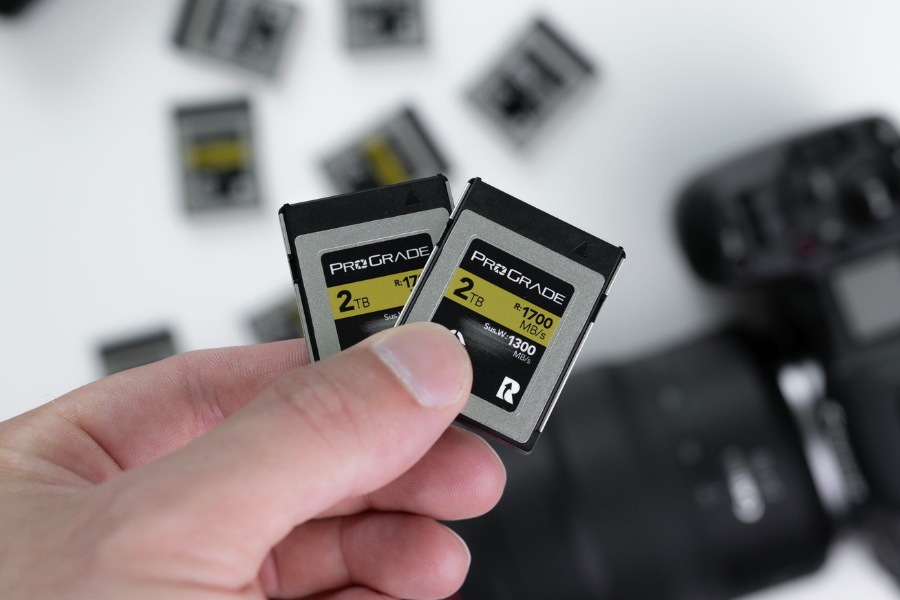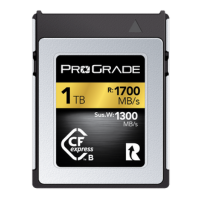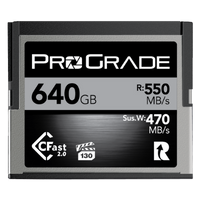In the fast-paced world of photography and videography, capturing moments with precision and artistry is paramount. As photographers and videographers, we rely heavily on memory cards to store our precious visual creations. These tiny storage devices have revolutionized the way we document the world, offering convenience and high storage capacities that enable us to shoot countless images and hours of video.
However, in the ever-evolving landscape of creative work, ensuring the safety and integrity of your data is of utmost importance. As your visual portfolio grows, so does the significance of safeguarding your valuable work. Accidents can happen, and having a robust data management strategy is essential to prevent any potential loss.
This is why secure data storage and backup are not just optional practices but fundamental pillars of your photography and videography workflow. Implementing reliable data safety measures will protect your hard work and creative investments, providing you with peace of mind as you focus on capturing captivating visuals that tell your unique story.
In this comprehensive guide, we will walk you through essential techniques and best practices to secure your data on a memory card. These steps will empower you to safeguard your efforts and cherish your artistic accomplishments for years to come.
Understanding How Memory Cards Store Data
To effectively secure and back up your data on a memory card, it’s essential to grasp how these miniature marvels store information. Understanding the data storage process of a memory card will shed light on the potential risks of data loss or corruption, prompting you to adopt proactive measures for data safety.
Memory cards, commonly used in cameras and other electronic devices, utilize flash memory technology to retain data even when the power is turned off. In other words, flash memory cells are electrically charged when data is written to them and remain that way until they are discharged. This allows memory cards to hold data after you remove the card from the camera or its reader.
Each time you snap a photo with a digital camera, its sensor meticulously converts every pixel of the image into a precise sequence of ones and zeros. These ones and zeros will then be stored on a memory card. For that, flash memory has small cells that act as switches. If a switch is “on,” it stores a 1; if it’s “off,” it stores a 0.
While memory cards are designed for robust and reliable performance, they are not impervious to certain risks that could lead to data loss or corruption. Some of these risks include:
- Physical Damage: High-quality memory cards are generally resistant to water damage, intense temperatures, and even magnetic fields. That said, mishandling or exposing memory cards to adverse conditions can cause irreversible damage, potentially leading to data loss.
- Human Errors: Accidental deletion or formatting of data is a common risk, especially when navigating through multiple files or reformatting memory cards without backing up essential data.
- External Factors: Sudden power outages or interruptions during data transfer can cause data corruption on the memory card.
- End of Life: Like all electronic devices, memory cards have a limited lifespan. It is by no means short, contrary to widespread belief, but over the years, the integrity of the memory cells may degrade, increasing the likelihood of data errors or failures.
While these risks may seem daunting, taking proactive steps to mitigate them can significantly enhance data safety on memory cards. In the following sections, we will explore various techniques and best practices to safeguard your data effectively and establish a robust backup strategy that ensures the preservation of your valuable work.
Best Practices for Safe Data Storage on Memory Cards
Ensuring the safety of your data on a memory card requires adopting a set of best practices that protect your valuable content from potential risks. By following these guidelines, you can significantly reduce the chances of data loss or corruption, allowing you to focus on your creative pursuits with peace of mind:
- Safely Remove the Card: Safely Remove the Card: After capturing stunning shots or recording captivating videos, always remember to safely remove the memory card from your camera or device. The proper method to eject the card usually involves the following steps:
- For Cameras: Most cameras have a dedicated button or option in the menu to safely eject the memory card. It’s usually marked with an icon that represents the card. Pressing this button or selecting the option will disengage the card, allowing you to safely remove it. However, for cameras without a dedicated eject button, first ensure the camera is powered off completely before gently removing the card. Always ensure that you’re not in the middle of saving or transferring any files.
- For Computers or Other Devices: If the memory card is in a computer or other device, it’s best to go to the file explorer and find the eject option (often right-clicking on the device). Once selected, the operating system will safely disengage the card, notifying you when it’s safe to remove.
Abruptly pulling the card out without following these methods could lead to data corruption or damage. It’s always best to consult your device’s manual for specific instructions, as the methods can vary between manufacturers and models.
- Pay Attention to Your Camera’s Battery Life: In a fast-paced environment, encountering a drained battery mid-shot can be quite a challenge. Your instinct might be to swiftly replace the battery, but doing so without caution could result in data loss. Even if your camera indicates an empty battery, it may still be in the process of writing the tail of the video or image. To prevent data loss, it’s essential to exercise patience and allow your camera to complete this writing process before swapping the battery. Better yet, replace the battery way before it runs out. Taking this precautionary step ensures that your valuable data is securely saved, giving you peace of mind during critical shooting moments.
- Don’t Push Past Manufacturer Recommended Temperatures: Every memory card has an optimal operating and storage temperature specified by the manufacturer. Avoid going against these recommendations. Make sure you are familiar with the temperature limitations of the card you are using, as these vary greatly. While professional-grade cards built for harsh conditions, like ProGrade Digital memory cards, can safely handle -10°C to 70°C, most consumer-grade memory cards are typically designed to operate within a much narrower range. Generally between 0°C to 40°C (32°F to 104°F).
- Do Not Use Memory Cards When Wet: A high-quality memory card has a higher chance of continuing to work after you happen to leave it out in the rain or accidentally submerge it. Just make sure the card (especially its connectors) is completely dry before you use it again.
- Keep the Card Clean: Dust and debris are not usually harmful to your data on a memory card. However, similar to the previously mentioned water exposure, when inserting or removing the card from your camera or card reader, ensure that the contacts and slots remain free from dirt and particles. Also, keep in mind that features like “dust resistance” are not meant to be exploited, and they are not the default characteristics of all memory cards. Exposure to elements can be detrimental to cheaper memory cards. Keeping your memory cards clean and well-maintained ensures your data integrity and prolongs the lifespan of your memory cards.
- Use Protective Cases: Invest in high-quality protective cases for your memory cards to shield them from physical damage and environmental elements. These cases offer an added layer of security during storage and transport.
- Rotate and Refresh Cards: Avoid using a single memory card continuously for extended periods. Instead, rotate between multiple cards to distribute data and reduce wear on individual cards. Additionally, consider refreshing your cards periodically by formatting them to maintain optimal performance. Learn more: How to Maintain Memory Cards.
- Label and Organize Cards: Adopt a systematic approach to labeling and organizing your memory cards. This practice will help you keep track of the content on each card and minimize the risk of confusion or accidental deletions.
- Use Reliable Brands: Invest in memory cards from reputable and reliable brands. High-quality memory cards are less prone to failures and offer better longevity for your data. Likewise, use high-quality memory card readers, as your data is only as secure as the weakest link in your data management workflow.
- Regularly Backup Data: Backing up your data on a separate storage device is a key step in data safety. Create duplicate copies of your images and videos on a computer, external hard drive, or cloud storage to ensure redundancy and protection against accidental data loss.
By adhering to these best practices, you can create a robust foundation for secure data storage on your memory cards. Embrace these habits as part of your regular workflow to safeguard your creative endeavors and cherish the fruits of your artistic labor with confidence. In the next section, we will explore how to implement effective backup strategies to further fortify your data safety net. Let’s continue our journey towards ensuring the integrity and longevity of your precious visual creations.
Secure Your Data on a Memory Card: How to Backup Memory Cards
Data backup is critical to secure your data on a memory card and ensure the safety and preservation of your creative endeavors. Among the various backup methods available, utilizing external hard drives stands as one of the most reliable and widely practiced approaches. Let’s delve into the essential protocols for securely backing up your data:
- Multiple Copies: Creating multiple copies of your memory card data is a fundamental rule of data safety. As a best practice, aim to have at least two copies of your files stored on separate external hard drives.
- Immediate Backup: After a photoshoot or recording session, make it a priority to back up your data as soon as possible. Avoid postponing the process to minimize the risk of data loss due to accidents or mishaps.
- Never Delete from the Card: A cardinal rule in data management is to never delete anything from your memory card until you have at least two verified copies on your backup drives. Deleting data prematurely could lead to irreversible loss.
- Verify Your Backups: Regularly verify the integrity of your backup files. Run verification checks to ensure that all data has been accurately copied to the external hard drives without any errors.
- Consistent Backup Routine: Establish a consistent backup routine that aligns with your workflow. Whether it’s after each shoot, at the end of the day, or after completing a project, having a predictable schedule for backing up your data reinforces the safety of your files.
- Label and Organize: Properly label and organize your backup drives to maintain clarity and accessibility. Use descriptive naming conventions to quickly identify specific shoots or projects.
- Store Offsite: Consider storing one of your backup drives offsite, away from your primary work location. This offsite storage provides an additional layer of protection in case of any physical mishaps or disasters.
- Implement Redundancy: Explore RAID configurations or backup mirroring to introduce redundancy into your backup system. Redundancy ensures that your data remains accessible even if a single drive fails.
- Protect from Physical Damage: Store your external hard drives in protective cases or sturdy storage solutions to shield them from physical damage or environmental hazards.
- Regular Data Checks: Periodically check and update your backup drives to ensure that they are functioning correctly and have enough free space for new data.
Remember, data loss can happen unexpectedly, and having a comprehensive backup protocol is your safety net against such incidents. By following these practices and prioritizing data security, you can confidently pursue your creative endeavors, knowing that your files are diligently preserved and ready for future use.
Facing Data Disasters: What to Do When Data is Lost or Corrupted
Despite taking extensive precautions, data disasters can still occur, leaving you grappling with the fear of losing your valuable files from a memory card. In such unfortunate situations, it’s essential to act strategically to maximize your chances of data recovery.
Losing data can be distressing, but it’s important to remain calm and composed. Panic may lead to hasty decisions that could worsen the situation. Take a deep breath, assess the situation, and approach the recovery process methodically:
- Stop Using the Card: If you encounter data corruption or realize files are missing, immediately stop using the memory card. Continued use may overwrite or damage the lost data, reducing the chances of recovery.
- Verify the Issue: Ensure that the data loss or corruption is genuinely a memory card problem and not a camera or device-related issue. Test the memory card in different devices to rule out any compatibility problems.
- Check Physical Connections: Sometimes, the card may appear corrupt due to loose or dirty connections between the memory card and the device. Carefully inspect and clean the card’s and reader’s contacts and try inserting it again.
- Backup and Clone the Card: Before attempting any data recovery procedures, consider making a backup or clone of the memory card. This precaution ensures that you have an exact replica of the original data, providing a safety net in case recovery attempts have unforeseen consequences.
- Attempt DIY Data Recovery: If the data loss is due to accidental deletion or quick formatting, you can try using data recovery software to retrieve your files. Follow the instructions provided by the software and attempt the recovery cautiously.
For cases where the DIY approach does not yield the desired results or when data loss is due to physical damage, it’s best to seek professional data recovery services. Specialized data recovery companies have the expertise and equipment to handle complex data retrieval tasks and improve the chances of successful recovery.
Data recovery processes can be time-consuming, especially when dealing with large memory cards or extensive data. Be patient and allow the recovery software or professionals ample time to conduct a thorough scan and retrieval process.
Use the data loss incident as an opportunity to reevaluate your data safety practices and backup strategies. Identify any gaps in your approach and implement additional measures to prevent similar situations in the future.
Conclusion: Embrace Secure Data Storage and Backup for Peace of Mind
Secure data storage and backup are paramount to preserving your creative journey. Safeguarding your visual creations against unforeseen disasters empowers you to pursue your artistry with confidence and passion. By adhering to best practices, such as implementing a consistent backup routine, you fortify the safety net for your valuable data.
Remember, prevention is the key to data preservation. So, put these tips into practice, and let your creative spirit soar unburdened, knowing your visual masterpieces are protected and ready to inspire the world.





